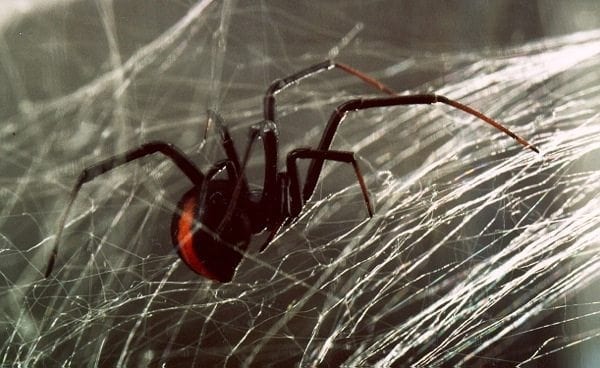Redback Spider
Redback Spider bites are the most common envenoming in Australia. Venom is from the latrodectus genus which is abundant in different countries around the world. Some of which use antivenom and some do not. This is a hotly debated topic in toxicology.
Classically an intense pain develops 5-10 minutes after a bite, followed by sweating and piloerection on the affected limb. The pain is usually controlled by analgesia but there are a spectrum of patients who develop systemic features that can be debilitating the the use of antivenom remains controversial.
- Latrodectus hasselti: Redback spider, Australia
- Latrodectus katipo: Katipo spider, New Zealand
Resus
- Redback spider envenomation is not life threatening.
Risk Assessment
Typical symptoms include:
- Local bite site pain followed by sweating and piloerection within an hour. A puncture mark may not always be present
- Systemic envenoming occurs in a minority causing regional and then generalised pain (classic stories of appendicitis mimics). Autonomic features include severe sweating, hypertension and tachycardia.
- Non-specific features include a headache, nausea, vomiting and dysphoria.
- Children may present with inconsolable crying, abdominal pain and priapism
- Untreated symptoms usually resolve in 1-4 days with a few patients feeling unwell for unto one week
Supportive Care
- Analgesia First aid measures including an ice pack and simple analgesia including paracetamol and ibuprofen are often effective. For those patients refractory to this oral opiates like oxycodone 0.1 mg/kg (max 10mg) every 4 hours have been effective before proceeding to IV opiates (0.1 mg/kg of morphine).
- Antivenom maybe used in cases of severe pain refractory to opiates and severe systemic features after an informed discussion with the patient. See Controversies section.
Investigations
- Not required
Differential Diagnosis:
- Envenoming by cupboard or brown house spiders closely resembles a redback spider envenomation
- Funnel-web spider envenoming should not be mistaken for a redback as these can potentially be fatal. Funnel-webs are associated with immediate pain, fang marks with characteristic sweating, agitation, piloerection, cardiovascular and neurological symptoms.
Antivenom
- CSL Redback Spider Antivenom Used to treat moderate to sever pain and systemic symptoms. Recent literature has questioned its utility but there is also longstanding anecdotal experience in patients with severe symptoms showing some benefit. The pro’s and con’s (risk of anaphylaxis) need to be discussed with the patient before use and it would be worth discussing with your local toxicology team for their advice
Disposition
- Envenomed patients maybe discharged when their symptoms are mild or under control
Controversies
- The latest trial regarding antivenom administration for latrodectism (RAVE II) suggests there is no significant clinical benefit above standard analgesia for the control of pain and systemic symptoms of redback envenoming.
References and Additional Resources:
Additional Resources:
- Hensley J. Has the bell tolled for redback antivenom? EBM Gone Wild
- Nickson C. Does Antivenom Work? CCC
- Nickson C. Bitten by a Redback Spider. LITFL
- Nickson C. Is this a RedBack I see before me? LITFL
Zeff – James Hayes Fellowship teaching Spider bite
References:
- Isbister GK, Brown SGA, Miller A et al. A randomised controlled trial of intramuscular versus intravenous antivenom for lactrodectism – the RAVE study. Quarterly Journal of Medicine 2008; 101:557-565
- Isbister GK, Gary MR. Lactrodectism: A prospective cohort study of bites by formally identified redback spiders. Medical Journal of Australia 2003; 179:88-91
- Isbister GK, O’Leary MA, Miller M et al. A comparison of serum antivenom concentrations after intravenous and intramuscular administration of redback (widow) spider antivenom. British Journal of Clinical Pharmacology 2008; 65:138-143
- Isbister GK, Page CB, Buckley NA et al. Randomised controlled trial of intravenous antivenom versus placebo for lactrodectism: the second redback antivenom evaluation (RAVE II) study. Annals of Emergency Medicine 2014; 64:1-9
- Isbister GK, Sibbritt D. Developing a decision tree algorithm for the diagnosis os suspected spider bites. Emergency Medicine Australia 2006; 16:161-166
- Isbister GK. How to treat suspected spider bite. Australian Doctor 2004 Sept. 27-35

Toxicology Library
TOXINS
Dr Neil Long BMBS FACEM FRCEM FRCPC. Emergency Physician at Kelowna hospital, British Columbia. Loves the misery of alpine climbing and working in austere environments (namely tertiary trauma centres). Supporter of FOAMed, lifelong education and trying to find that elusive peak performance.

